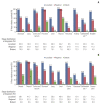Cancer Statistics in Korea: Incidence, Mortality, Survival, and Prevalence in 2017
- PMID: 32178489
- PMCID: PMC7176962
- DOI: 10.4143/crt.2020.206
Cancer Statistics in Korea: Incidence, Mortality, Survival, and Prevalence in 2017
Abstract
Purpose: This study reports the cancer statistics and temporal trends in Korea on a nationwide scale, including incidence, survival, prevalence, and mortality in 2017.
Materials and methods: The incidence, survival, and prevalence rates of cancer were evaluated using data from the Korea National Cancer Incidence Database from 1999 to 2017 with follow-up until December 31, 2018. Deaths from cancer were assessed using cause-of-death data from 1983 to 2017, obtained from Statistics Korea. Crude and age-standardized rates (ASRs) for incidence, mortality, and prevalence, and 5-year relative survival rates were calculated and trend analysis was performed.
Results: In 2017, newly diagnosed cancer cases and deaths from cancer numbered 232,255 (ASR, 264.4 per 100,000) and 78,863 (ASR, 76.6 per 100,000), respectively. The overall cancer incidence rates increased annually by 3.5% from 1999 to 2011 and decreased by 2.7% annually thereafter. Cancer mortality rates have been decreasing since 2002, by 2.8% annually. The 5-year relative survival rate for all patients diagnosed with cancer between 2013 and 2017 was 70.4%, which contributed to a prevalence of approximately 1.87 million cases by the end of 2017.
Conclusion: The burden of cancer measured by incidence and mortality rates have improved in Korea, with the exception of a few particular cancers that are associated with increasing incidence or mortality rates. However, cancer prevalence is increasing rapidly, with the dramatic improvement in survival during the past several years. Comprehensive cancer control strategies and efforts should continue, based on the changes of cancer statistics.
Keywords: Incidence; Korea; Mortality; Neoplasms; Prevalence; Survival.
Conflict of interest statement
Conflict of interest relevant to this article was not reported.
Figures







References
-
- Bray F, Ferlay J, Soerjomataram I, Siegel RL, Torre LA, Jemal A. Global cancer statistics 2018: GLOBOCAN estimates of incidence and mortality worldwide for 36 cancers in 185 countries. CA Cancer J Clin. 2018;68:394–424. - PubMed
-
- GBD 2017 Disease and Injury Incidence and Prevalence Collaborators Global, regional, and national incidence, prevalence, and years lived with disability for 354 diseases and injuries for 195 countries and territories, 1990-2017: a systematic analysis for the Global Burden of Disease Study 2017. Lancet. 2018;392:1789–858. - PMC - PubMed
-
- Ajiki W, Tsukuma H, Oshima A. Index for evaluating completeness of registration in population-based cancer registries and estimation of registration rate at the Osaka Cancer Registry between 1966 and 1992 using this index. Nihon Koshu Eisei Zasshi. 1998;45:1011–7. - PubMed
Publication types
MeSH terms
Grants and funding
LinkOut - more resources
Full Text Sources
Medical
Miscellaneous

